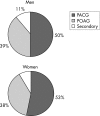Prevalence of glaucoma in rural Myanmar: the Meiktila Eye Study
- PMID: 17510475
- PMCID: PMC1955608
- DOI: 10.1136/bjo.2006.107573
Prevalence of glaucoma in rural Myanmar: the Meiktila Eye Study
Abstract
Aim: To determine the prevalence of glaucoma in the Meiktila district of central, rural Myanmar.
Methods: A cross-sectional, population-based survey of inhabitants > or =40 years of age from villages in Meiktila district, Myanmar, was performed; 2481 eligible participants were identified and 2076 participated in the study. The ophthalmic examination included Snellen visual acuity, slit-lamp examination, tonometry, gonioscopy, dilated stereoscopic fundus examination and full-threshold perimetry. Glaucoma was classified into clinical subtypes and categorised into three levels according to diagnostic evidence.
Results: Glaucoma was diagnosed in 1997 (80.5%) participants. The prevalence of glaucoma of any category in at least one eye was 4.9% (95% CI 4.1 to 5.7; n = 101). The overall prevalence of primary angle-closure glaucoma (PACG) was 2.5% (95% CI 1.5 to 3.5) and of primary open-angle glaucoma (POAG) was 2.0% (95% CI 0.9 to 3.1). PACG accounted for 84% of all blindness due to glaucoma, with the majority due to acute angle-closure glaucoma (AACG).
Conclusion: The prevalence of glaucoma in the population aged > or =40 years in rural, central Myanmar was 4.9%. The ratio of PACG to POAG was approximately 1.25:1. PACG has a high visual morbidity and AACG is visually devastating in this community. Screening programmes should be directed at PACG, and further study of the underlying mechanisms of PACG is needed in this population.
Conflict of interest statement
Competing interests: None.
Similar articles
-
Prevalence and risk factors for primary glaucomas in adult urban and rural populations in the Andhra Pradesh Eye Disease Study.Ophthalmology. 2010 Jul;117(7):1352-9. doi: 10.1016/j.ophtha.2009.11.006. Epub 2010 Feb 25. Ophthalmology. 2010. PMID: 20188420
-
Glaucoma in a rural population of southern India: the Aravind comprehensive eye survey.Ophthalmology. 2003 Aug;110(8):1484-90. doi: 10.1016/S0161-6420(03)00564-5. Ophthalmology. 2003. PMID: 12917161
-
Prevalence of primary angle-closure disease in an urban south Indian population and comparison with a rural population. The Chennai Glaucoma Study.Ophthalmology. 2008 Apr;115(4):655-660.e1. doi: 10.1016/j.ophtha.2007.05.034. Epub 2007 Sep 17. Ophthalmology. 2008. PMID: 17869343
-
Gonioscopy findings and prevalence of occludable angles in a Burmese population: the Meiktila Eye Study.Br J Ophthalmol. 2007 Jul;91(7):856-9. doi: 10.1136/bjo.2006.108688. Br J Ophthalmol. 2007. PMID: 17576708 Free PMC article. Review.
-
Blindness in glaucoma: primary open-angle glaucoma versus primary angle-closure glaucoma-a meta-analysis.Eye (Lond). 2022 Nov;36(11):2099-2105. doi: 10.1038/s41433-021-01802-9. Epub 2021 Oct 13. Eye (Lond). 2022. PMID: 34645961 Free PMC article.
Cited by
-
Prevention of primary angle-closure glaucoma in Asia.Br J Ophthalmol. 2007 Jul;91(7):847-8. doi: 10.1136/bjo.2006.111435. Br J Ophthalmol. 2007. PMID: 17576702 Free PMC article.
-
Differences in rates of glaucoma among Asian Americans and other racial groups, and among various Asian ethnic groups.Ophthalmology. 2011 Jun;118(6):1031-7. doi: 10.1016/j.ophtha.2010.10.024. Epub 2011 Feb 18. Ophthalmology. 2011. PMID: 21310489 Free PMC article.
-
Glaucoma and its predictors among adult patients attending ophthalmic outpatient department: a hospital-based study, North West Ethiopia.BMC Ophthalmol. 2021 Nov 19;21(1):400. doi: 10.1186/s12886-021-02168-y. BMC Ophthalmol. 2021. PMID: 34794419 Free PMC article.
-
Immediate changes in intraocular pressure after laser peripheral iridotomy in primary angle-closure suspects.Ophthalmology. 2012 Feb;119(2):283-8. doi: 10.1016/j.ophtha.2011.08.014. Epub 2011 Oct 29. Ophthalmology. 2012. PMID: 22036632 Free PMC article. Clinical Trial.
-
Prevalence and characteristics of glaucoma among Korean adults.Korean J Ophthalmol. 2011 Apr;25(2):110-5. doi: 10.3341/kjo.2011.25.2.110. Epub 2011 Mar 11. Korean J Ophthalmol. 2011. PMID: 21461223 Free PMC article.
References
Publication types
MeSH terms
LinkOut - more resources
Full Text Sources
Medical


